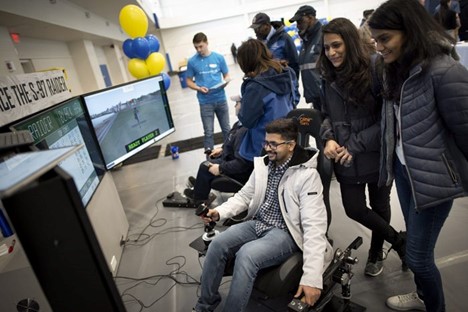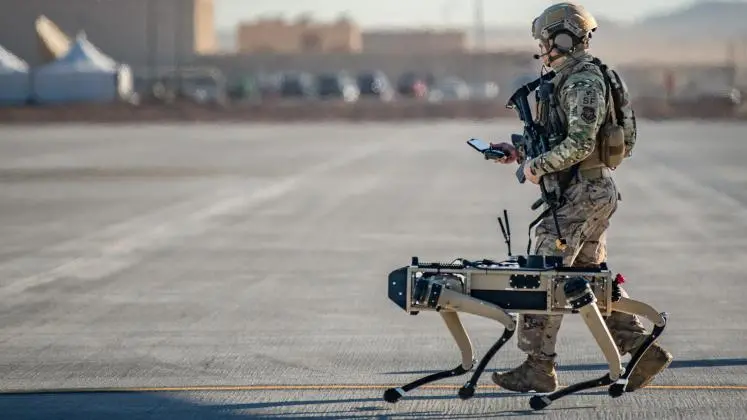
Will this be the future? Ferris State University’s military-supported bachelor program in AI is conducting an experiment by enrolling two AI’s alongside human students. (AI-generated image, including errors in object placement and perspective, from Getimg.ai)
By James Myers
With the obvious advantages that artificial intelligence brings to military operations and weapons development, major powers are investing heavily in educating today’s students to be leaders in the AI-powered battlegrounds of the future.
The military contest for the best and brightest minds to advance technological war capabilities is increasing as nations strive to dominate in the global AI arms race and fear falling behind. The competition is playing out on university campuses, most prominently in the U.S.
In 2022, the U.S. Department of Defense (DoD) provided $195 million in Multidisciplinary University Research Initiative (MURI) awards, funding 28 research teams for five years at 63 U.S. academic institutions. MURI awards have allowed the discovery of “novel energetics,” which might refer to new energy sources for weaponry, and “materials with unprecedented optical, thermal, and mechanical properties for a wide array of DoD application.”
In 2023, the DoD awarded $161 million to 281 universities for the procurement of defence-related equipment. In 2020, DoD announced $100 million of funding to the Texas A&M University to lead research in hypersonic flight systems for military use that is sought by many nations. These are among numerous examples of military funding of education.

Students experience a Lockheed Martin flight simulator at a February 2020 career fair at the University of Connecticut. Image: In These Times
At the same time, large military contractors maintain a significant presence on university campuses.
For instance, Lockheed Martin has held an annual event called Lockheed Martin Day on a dozen U.S. campuses to recruit students in STEM (science, technology, engineering, and mathematics) programs, and its website lists 61 “partner universities” where it provides STEM scholarships (see pdf of listing). Lockheed Martin makes the advanced F-35 fighter jet and earned a significant portion of its 2023 revenue of $67.6 billion from military contracts. In 2020, the company hired 2,600 interns, and provides grants to universities in addition to student scholarships.

Tuskegee University promoted the September 2019 Lockheed Martin Day helicopter hunt event. Image: Tuskegee University
In November 2023, U.S. Deputy Secretary of Defense Kathleen Hicks spoke on “The State of AI in the Department of Defense,” highlighting the acceleration of AI-related activities and the DoD’s cooperation with universities.
Seven months earlier, the Atlantic Council Commission on Defense Innovation Adoption released an interim report highlighting the need for the DoD “to accelerate the adoption of cutting-edge technology from the leading edge of the commercial and defense sectors.” Co-authored by former U.S. Defense Secretary Mark Esper, the report outlines many ways the Commission believes the U.S. is lagging its competitors and losing its once-dominant base of industrial partnerships.
Many of the report’s criticisms were echoed in Deputy Secretary Hicks’ August 2023 address, “The Urgency to Innovate,” in which she described the creation of the Combined Joint All-Domain Command and Control aimed at “integrating sensors and fusing data across every domain” of the military.

The U.S. Navy’s Middle East-based 5th Fleet experiments with autonomous marine drones serving in Task Force 59, which will test Replicator systems. Image: MC2 Jacob Vernier/U.S. Navy
At the same time, Hicks announced a new “Replicator initiative” under which the U.S. military will fund the development of autonomous systems to counter China’s “biggest advantage, which is mass. More ships. More missiles. More people.” Noting that, “This is about mastering the technology of tomorrow,” Hicks stated, “After all, we don’t use our people as cannon fodder like some competitors do.”
Replicator aims to create “multiple thousands” of autonomous systems in multiple domains within two years.
While the Brookings Institution found that 87% of the value of U.S. government contracts over a five-year period with “AI” in the description are managed by the DoD, it observes that the U.S. continues to lose ground to China’s aggressive pace of AI development.
Noting that “there is a global war for talent,” in 2020 the DoD released its Education Strategy (in a pdf document) to provide learning in AI for its workers. The Strategy document states, “the future of AI in the DoD relies on the Department’s ability to build and develop a workforce for the digital era. AI is a human-centric endeavor – developed by people, for people – and because humans will ultimately make the decisions that are informed by AI capabilities, an AI ready force is essential to delivering AI at scale. This includes both technical and non-technical roles, across all grades and ranks, civilian and military.”

Militarization of AI is underway. Image: US Department of Defense / Sgt. Cory D. Payne, public domain.
Last November, the DoD teamed with the Massachusetts Institute of Technology to offer digital on-demand courses on AI and technology to military and civilian workforces.
Researchers at MIT collaborate with DoD on a number of projects, including the development of a technology that uses a swarm of tiny robots to create lattice-like structures that could be used as bridges to transport troops across battlefields and water.
The military has an increasing interest in AI’s connection to neural and cognitive functions.
In May 2023, the DoD announced an award of $10 million to establish an institute dedicated to advancing unified research in artificial and natural intelligence, with co-funding from the National Science Foundation. The institute’s program “includes a DoD-sponsored focus area on the neural and cognitive foundations of AI.”
The reasons for the military’s interest in cognition are unclear. While strategic concerns might preclude full disclosure, a range of possibilities can be imagined, from cyberwarfare to troop enhancement. Tests now underway are helping to shape the course of the possible technological applications.

US President Dwight Eisenhower: “Every gun that is made, every warship launched, every rocket fired signifies, in the final sense, a theft from those who hunger and are not fed, those who are cold and are not clothed. This world in arms is not spending money alone. It is spending the sweat of its laborers, the genius of its scientists, the hopes of its children.” – April 16, 1953 speech. Image: Wikipedia
Ferris State University, in Michigan, is conducting an experiment to compare the cognitive function of AI to human students. The experiment is part of the university’s bachelor program in AI, which was developed with support from the DoD and works with the National Security Agency, the Department of Homeland Security, Amazon Web Services, and other industry players.
In the experiment, two virtual AI students are enrolled alongside human counterparts for the stated reasons of exploring possible new educational applications for AI and providing insights on the student experience, especially for remote learners.
Named Ann and Fry, the two AI’s began listening to lectures and completing assignments in the January 2024 semester, and will eventually be programmed to interact with the human students and participate in classroom discussions. Researchers are tracking the learning journey of Ann and Fry as the virtual students make decisions, choose courses, and navigate the educational system autonomously.
What does the future hold for the talent and creativity of today’s students in AI and STEM fields?
The global arms race has become a race of minds for the attention of minds, with a significant investment of money and national resources required to win. There are many possible paths the future could take, but as global militaries engage in a heated competition for a powerful AI advantage over each other, their investments in education are likely to continue attracting many universities and students.
What will the future of education look like?

We may soon have the first AI graduating alongside human students. Image: U3167879 on Wikipedia



